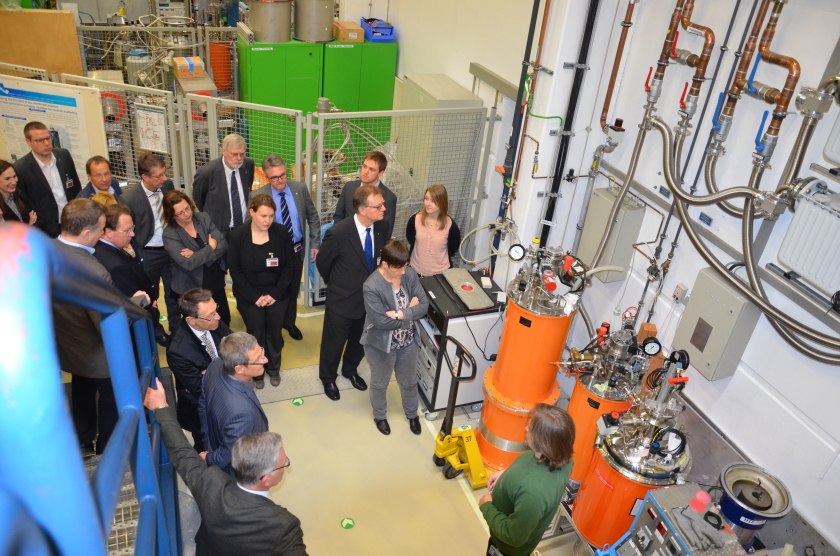Deutsche Gesellschaft für Materialkunde was a guest of HZB

Tour through the experimental hall of BER II.
From 15 to 16 March, the Deutsche Gesellschaft für Materialkunde, DGM (German association of materials science), held its closed board meeting and Advisory Council meeting at HZB. The experts took the occasion to visit the synchrotron source BESSY II and the neutron source BER II, gaining an insight into important future projects of HZB.
“It was a great pleasure to be host to the Deutsche Gesellschaft für Materialkunde, where we had the opportunity to present Helmholtz-Zentrum Berlin’s strategies and research infrastructures, which external researchers are also very welcome to use,“ says Prof. Dr. Anke Kaysser-Pyzalla, scientific director of HZB.
The board members of the DGM visited the control room and experimental hall of BESSY II on 15 March. On 16 March, the DGM Advisory Council toured the neutron guide hall at BER II and the CoreLab “Correlative Microscopy and Spectroscopy”, which is home to latest generation ZEISS electron and ion microscopes for use by external users and employees of HZB.
The Deutsche Gesellschaft für Materialkunde is dedicated to promoting continual advancements in topics, structures and careers in the field of materials science and engineering. Its strategies include fostering cooperation between universities, research institutions, companies, and national and international partners, and promoting new collaborative projects. The DGM organises many symposia and congresses that are also important information exchange platforms for many scientists of HZB.
(sz)
https://www.helmholtz-berlin.de/pubbin/news_seite?nid=14638;sprache=en
- Copy link
-
The twisted nanotubes that tell a story
In collaboration with scientists in Germany, EPFL researchers have demonstrated that the spiral geometry of tiny, twisted magnetic tubes can be leveraged to transmit data based on quasiparticles called magnons, rather than electrons.
-
Bright prospects for tin perovskite solar cells
Perovskite solar cells are widely regarded as the next generation photovoltaic technology. However, they are not yet stable enough in the long term for widespread commercial use. One reason for this is migrating ions, which cause degradation of the semiconducting material over time. A team from HZB and the University of Potsdam has now investigated the ion density in four different, widely used perovskite compounds and discovered significant differences. Tin perovskite semiconductors produced with an alternative solvent had a particular low ion density — only one tenth that of lead perovskite semiconductors. This suggests that tin-based perovskites could be used to make solar cells that are not only really environmentally friendly but also very stable.
-
Synchrotron radiation sources: toolboxes for quantum technologies
Synchrotron radiation sources generate highly brilliant light pulses, ranging from infrared to hard X-rays, which can be used to gain deep insights into complex materials. An international team has now published an overview on synchrotron methods for the further development of quantum materials and technologies in the journal Advanced Functional Materials: Using concrete examples, they show how these unique tools can help to unlock the potential of quantum technologies such as quantum computing, overcome production barriers and pave the way for future breakthroughs.
